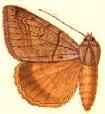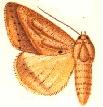
Mocis is a genus of moths in the family Erebidae. The genus was erected by Jacob Hübner in 1823.
Ophisma tropicalis is a moth of the family Noctuidae first described by Achille Guenée in 1852. It is found in tropical and subtropical America, from the south of the United States to Uruguay, including Brazil, Guadeloupe, Martinique, Saint Kitts, Montserrat, Saint Vincent, Grenada, the Greater Antilles, Cuba, the Dominican Republic, Jamaica and Colombia.

Ophisma pyrosticha is a moth of the family Noctuidae first described by Herbert Druce in 1912. It is found in South America, including Peru.

Ophisma tecta is a moth of the family Noctuidae first described by William Schaus in 1894. It is found in South America, including Brazil, French Guiana and Costa Rica.

Ophisma variata is a moth of the family Noctuidae first described by William Schaus in 1901. It is found in South America, including Costa Rica and Brazil.

Bastilla joviana is a moth of the family Noctuidae first described by Stoll in 1782. It is found from the Oriental region to the Moluccas and in New Guinea and Australia. It is also present in South Africa.

Caenurgia togataria is a species of moth of the family Erebidae. It is found in the southern parts of the United States, south to Mexico.

Mocis antillesia is a moth of the family Erebidae. It is found on the Lesser Antilles, Bahamas and British Virgin Islands.

Mocis cubana is a moth of the family Erebidae. It is found in Cuba and was first reported from the Florida Keys by John B. Heppner in 2003.

Mocis disseverans, the yellow mocis moth, is a moth of the family Erebidae. It is found in the Caribbean and parts of the southern United States, including Mississippi, Florida and Texas.

Mocis bahamica is a moth of the family Erebidae. It is found on the Bahamas.

Mocis diplocyma is a moth of the family Erebidae. It is found in South America, including Brazil and French Guiana.

Mocis discios is a moth of the family Erebidae. It is found in the Himalaya.

Mocis inferna is a moth of the family Erebidae. It is found in China.

Mocis vitiensis is a moth of the family Erebidae first described by George Hampson in 1913. It is found in Fiji.

Mocis trifasciata is a moth of the family Erebidae. It is found in the south-west Pacific region, including Samoa, Fiji, Hawaii, New Zealand, the Society Islands and Queensland.

Mocis escondida is a species of moth of the family Erebidae. It is found in Brazil (Parana).

Mocis ramifera is a species of moth of the family Erebidae. It is found in South America, including Peru.

Mocis undifera is a species of moth of the family Erebidae. It is found in South America, including Ecuador.

Photedes enervata, the many-lined cordgrass moth, previously known as Hypocoena enervata, is a species of moth of the family Noctuidae. It is found in marshes along the Atlantic Coast of North America, with scattered inland wetlands records from Nova Scotia and New Brunswick south to Florida.

